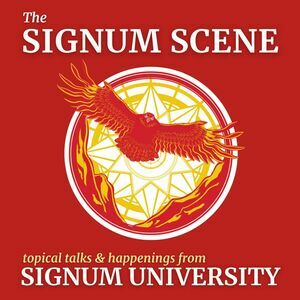Episode 7
Guest Lecture Series Tom Shippey – Myth in Modern Fantasy
September 9th, 2015
1 hr 21 mins 38 secs
Your Hosts
About this Episode
<p style="text-align: center">This free online lecture is part of the <a href="http://mythgard.org/academy/guest-lecture-series/">Mythgard Academy Guest Lecture Series</a>.</p>
<img class=" size-medium wp-image-8877 alignleft" src="http://mythgard.org/wp-content/uploads/sites/15/2015/08/GLS_Tom_Shippey-300x225.jpg" alt="Tom Shippey" width="300" height="225" />
Both mythical studies and the study of fairy-tales took on new importance during the early nineteenth century, along with the entirely new development of comparative philology. Jacob Grimm was in all three cases the pivotal figure. The relationship between them continued to fascinate both scholars and creative writers, including Andrew Lang, C. S. Lewis, J. R. R. Tolkien, and their successors. This lecture will show how scholarly research acted as a direct stimulus for many creative writers.
<h2></h2>
<h3>Recordings from Thursday, Sept. 10</h3>
<em>Watch:</em> <a href="https://s3.amazonaws.com/media.mythgardacademy/GuestLectureSeries/2015-09-10_TomShippeyMythInModernFantasy.mp4">Video</a>
<em>Listen:</em> <a href="https://s3.amazonaws.com/media.mythgardacademy/GuestLectureSeries/2015-09-10_TomShippeyMythInModernFantasy.mp3">Audio</a>
<h2>Suggested Reading</h2>
<ul>
<li>C.S. Lewis, <em><a href="http://www.amazon.com/gp/product/0743234928/ref=as_li_tl?&tag=mythgaintit-20" rel="nofollow">That Hideous Strength</a></em> (1954)</li>
<li>C.S. Lewis, <em><a href="http://www.amazon.com/Till-We-Have-Faces-Retold/dp/0156904365/ref=sr_1_1?tag=mythgainstit-20" rel="nofollow">Till We Have Faces</a></em> (1976)</li>
<li>J.R.R. Tolkien, "On Fairy Stories," in <em><a href="http://www.amazon.com/Tolkien-Reader-J-R-R/dp/0345345061/ref=sr_1_1?tag=mythgainstit-20" rel="nofollow">The Tolkien Reader</a></em> (1966)</li>
</ul>
<h2>Background Reading</h2>
<ul>
<li>Bruno Bettelheim, <em><a href="http://www.amazon.com/Uses-Enchantment-Meaning-Importance-Fairy/dp/0307739635/ref=sr_1_1?tag=mythgainstit-20" rel="nofollow">The Uses of Enchantment</a></em> (1976, pick a chapter or two from Part Two, which deals with individual fairy-tales)</li>
<li>Derek Brewer, "The Interpretation of Fairy Tales", in <em><a href="http://www.amazon.com/Companion-Fairy-Hilda-Ellis-Davidson/dp/1843840812/ref=sr_1_1?tag=mythgainstit-20" rel="nofollow">A Companion to the Fairy Tale</a></em>, ed. Hilda Ellis Davidson and Anna Chaudhuri, 15-37</li>
<li>Sir James Frazer, <em><a href="https://www.gutenberg.org/files/3623/3623-h/3623-h.htm" rel="nofollow">The Golden Bough</a></em> (many editions from 1890: just skip-read the first 3 chapters)</li>
<li>Allan G. Hunter, <em><a href="http://www.amazon.com/Princes-Frogs-Ugly-Sisters-Brothers/dp/1844091848/ref=sr_1_1?tag=mythgainstit-20" rel="nofollow">Princes, Frogs and Ugly Sisters</a></em> (2010, just pick one or two chapters out, as with Bettelheim above)</li>
<li>Robert A. Segal, <em><a href="http://www.amazon.com/Myth-Short-Introduction-Robert-Segal/dp/0192803476/ref=sr_1_1?tag=mythgainstit-20" rel="nofollow">Myth: A Very Short Introduction</a></em> (2004)</li>
<li>Tom Shippey, "Rewriting the Core," in <em><a href="http://www.amazon.com/Companion-Fairy-Hilda-Ellis-Davidson/dp/1843840812/ref=sr_1_1?tag=mythgainstit-20" rel="nofollow">A Companion to the Fairy Tale</a></em>, above, 253-74</li>
</ul>
<h2>Biography</h2>
<a href="http://www.mythgard.org/about/our-faculty/dr-tom-shippey/"><strong>Tom Shippey </strong></a>holds a PhD from Cambridge University and served for many years as the Chair of Humanities at Saint Louis University’s College of Arts and Sciences. He is a scholar of medieval literature, Anglo-Saxon language and literature, medievalism, modern fantasy, and science fiction. He is one of the world’s leading scholars on the works of Tolkien. <a href="http://smile.amazon.com/Road-Middle-earth-Tolkien-created-mythology-ebook/dp/B00I7JFC5Y/ref=sr_1_1?ie=UTF8&qid=1423358483&sr=8-1&keywords=tom+shippey">His publications include <em>The Road to Middle-earth</em></a><em>, </em><a href="http://smile.amazon.com/J-R-R-Tolkien-Century-Tom-Shippey/dp/0618257594/ref=sr_1_2?ie=UTF8&qid=1423358483&sr=8-2&keywords=tom+shippey"><em>J.R.R. Tolkien: Author of the Century</em></a>, and <a href="http://smile.amazon.com/Oxford-Book-Science-Fiction-Stories/dp/0192803816/ref=sr_1_3?ie=UTF8&qid=1423358483&sr=8-3&keywords=tom+shippey"><em>The Oxford Book of Science Fiction Stories</em></a>. He has published many articles on <em>Beowulf</em> and Anglo-Saxon literature. He was born in Calcutta, India, and as a child played with a friend’s full-grown pet Bengal tiger.
